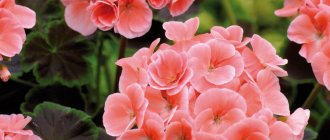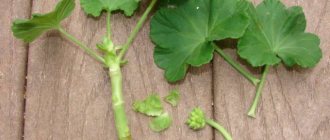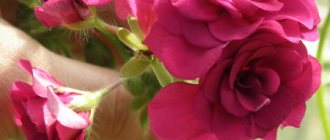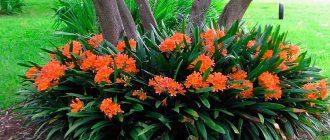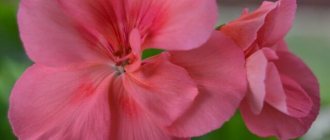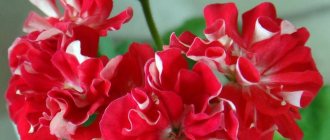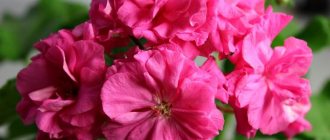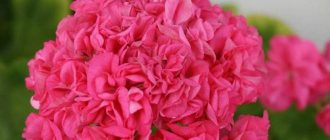Pelargoniums are one of the most beautiful types of indoor and garden flowers. They came to us from the hot African continent. To adapt this wonderful plant to new conditions, scientists have made a lot of efforts. Many beautiful varieties, species and varieties of this plant have appeared, including “Salmon,” beloved by indoor gardeners.
Varieties
Before moving on to the description of species and varieties, it is worth noting that many people confuse pelargonium with geranium. These are two different plants, and they have many differences, but since the name “geranium” is more familiar to our ears, we will henceforth use it.
A very beautiful zonal variety. The flowers of the plant are bright pink, with a rich salmon tint. Very decorative leaves with a brown central zone and a neat green edging make the lush spherical inflorescences of “Night” even more enchanting. In soft evening light, the flowers seem to glow from within. Over the course of a season, more than 50 gorgeous inflorescences can appear on a bush.
The height of pelargonium is from 25 to 35 cm. The plant is compact, branched.
With proper care, the variety can bloom all year round.
PAC Salmon Komtess
This zonal hybrid variety is the achievement of German breeders, whose task was to develop beautiful and unpretentious varieties for landscaping squares and parks. The uniqueness of the plant is that it can survive frosts down to -7 degrees, which is completely unusual for African sissies. The variety blooms profusely and is very easy to care for.
The bush is compact, very graceful, about 35 cm high. The leaves of the plant are velvety, dark green. The inflorescences of double flowers are large, collected in rich clusters. Lush pink caps look very impressive against the background of the dark greenery of the bush.
PAC Salmon Queen
A delightful zonal geranium worthy of any queen. Among the bright green foliage with dark chocolate-colored edging, lush caps of simple flowers of light peach color with a bright salmon-colored star-shaped center look stunning.
Plant height – up to 35 cm.
The flower is grown in summer in flower beds and on balconies.
Pac Salmon Princess
The amazingly beautiful representative of the pelargonium “Salmon” is distinguished by a very lush compact bush of medium size. The spherical inflorescences consist of large semi-double flowers of a soft creamy color, with a pinkish tint in the middle.
The number of flowers on a peduncle varies from 8 to 10 pieces. Under the weight of the lush caps, the flower stalks will elegantly bend down. The variety is perfect for decorating balconies and terraces in the summer.
"Bulls Eye"
This geranium is designed for professional cultivation. It will adequately decorate the terraces of prestigious cafes and restaurants, flower beds of large public institutions on the central streets of cities. It has dense elastic leaves. Bright pink large ball-inflorescences on low fleshy peduncles reach 15 cm in diameter. The height of the plant is almost 40 cm. The stems are powerful, large, and are not afraid of bad weather.
The variety looks very presentable in tall powerful flowerpots. The plant grows voluminous and lush.
You can plant it in a home flower garden, in a spacious, well-lit place where there will be no direct burning rays of the sun.
"Mephisto F1 Salmon"
A wonderful professional zonal variety. Height – 35 cm. The shoots are strong, branch well, forming a beautiful spreading bush. The leaves of the plant are round, chocolate-colored, with a bright green edge and an elegant wavy edge. The inflorescences are dense, uniform, and come in various colors:
- "Mephisto F1 Scarlet" - juicy red inflorescences;
- "Mephisto F1 Rose" - rich pink-lilac flowers.
"Inspire"
A universal variety of geranium that grows well indoors and in flower beds, looks great on balconies and loggias. Flowering is bright and abundant all summer. Inflorescences of juicy salmon color are collected in spherical inflorescences up to 10 cm in diameter.
About pelargonium pac salmon komtess (pac salmon komtess): description of the variety, care
Geranium of this variety grows up to 35 cm in height. The diameter of the bush is from 20 to 25 cm. Suitable for growing in open and closed ground. The flower prefers to grow in sunny areas, but also tolerates partial shade. Inflorescences bloom in the year of sowing. The color of the flowers and their appearance depend on the variety.
Geranium Night Salmon
These plants belong to the group of zonal pelargoniums. The most common varieties are described below.
Night Salmon F1
Pelargonium Night Salmon or Pelargonium Brocade Night Salmon is distinguished by large spherical inflorescences. Salmon-colored flowers. With proper care it blooms all year round.
PAC Salmon Komtess
Terry inflorescences, light pink. The edges of the petals have a white border.
PAC Salmon Queen
Pelargonium Pac Salmon Queen forms large inflorescences collected from several flowers. The petals are pink with a light pink border around the edges. Pelargonium Pak Salmon Queen blooms early. The variety is unpretentious in care.
Priory Salmon
Pelargonium Priori Salmon is distinguished by unusual inflorescences. The flower petals are thin and long, light salmon in color.
PAC Salmon Princess
Double inflorescences, light pink flowers. In appearance it resembles the pelargonium variety Salmon Queen.
It is better to plant a flower in the spring, when the growing season has just begun. Before planting, you need to add a layer of drainage to the bottom of the pot. Then you can plant the plant.
Pelargonium Salmon Queen, like other varieties, prefers moderate watering with warm, settled water. The flower can be sprayed 1-2 times a week.
Important! It needs fertilizing during the growing season, when the flower forms buds. Complex mineral fertilizers for flowering plants are added to the soil.
Trimming
Pelargonium does not need frequent pruning. You need to regularly cut off faded inflorescences and yellowed leaves.
Pruning pelargonium
Reproduction
The most common way to propagate flowers is by cuttings. The best time for cuttings is summer or winter.
How to propagate from cuttings:
- The apical cuttings are cut at an angle of 45 degrees. Each of them should have 3 leaves.
- Before rooting, the cut area is sprinkled with charcoal.
- The prepared cuttings are planted in the ground.
- The sprout is watered and covered with a cap.
Once a day, the cap should be removed for 10 minutes. After a few weeks it will be possible to remove the cap completely.
Rooting usually takes 4-5 weeks. The first inflorescences will appear approximately 5-7 months after planting the cuttings.
READ MORE: Options for redevelopment of a two-room Khrushchev house photo
Important! The crop can be propagated by seeds, but this is a labor-intensive and ineffective method.
Graceful ornamental plants decorate any room. Pelargonium zonalis blooms for six months and has lush foliage. Its main feature is its unpretentiousness.
Description of pelargonium
Pelargonium Zonale belongs to the Geraniaceae family and the genus Geranium, which has 400 different representatives. Visually, these species bear little resemblance to indoor plants. Therefore, it is not entirely correct to call zonal pelargonium geranium from a scientific point of view, but in the everyday sense such a term can be used.
The color of pelargonium flowers can be very different.
Origin
The plant's homeland is Africa, and pelargonium was brought to Europe only in the 17th century. These flowers began to be grown in Holland. Today, thanks to serious breeding work, a variety of varieties have been developed.
Pelargoniums began to appear in botanical gardens in different countries and in private collections. Due to constant breeding, the original characteristics of the plant were lost, but in the end it was possible to obtain specimens with unusual leaf colors and aesthetic flowering.
Today, zonal pelargonium (geranium) is very popular among gardeners from all over the world.
Important! In warm countries it is planted in flower beds, where it blooms beautifully and attracts attention. It is also grown as a houseplant.
Not everyone knows the history of the origin of the name “zonal pelargonium” and what it means. It's all about the unusual color of the leaves - they have a pronounced dark “rim”. It can be brown, purple, dark green, chocolate, burgundy.
There is one classification and it is based on the division by height. Mini geraniums do not exceed 13 cm in length, dwarf geraniums - 20 cm, medium geraniums - 60 cm, tall ones - 80 cm.
It is best to divide pelargoniums by variety, but in this case you need to carefully study the description of each species.
Thanks to long-term selection work, which has not yet stopped, the gardener can choose different pelargoniums. They differ in size, color and shape of inflorescences.
"Yu jig"
Common standard option. The stem is straight, the plant reaches medium height. The inflorescences are dense, double, and have a delicate coral hue. Pelargonium Yu Jig will delight any lover of indoor plants with its flowering.
An unpretentious variety, which is distinguished by spherical inflorescences of salmon color, the edges of the petals are slightly lighter. The leaves are rounded with a brown zone. Pelargonium reaches medium size.
Rafaella F1
A compact plant whose height does not exceed 30 cm. Adapted for growing in flower beds, balconies and in rooms.
Double flowers can be colored milky, peach, orange or scarlet.
Important! With proper care it blooms throughout the year.
The variety is quite new and therefore difficult to find on sale. Pelargonium is adapted to different conditions, so it tolerates heat and cold.
READ MORE: Chipboard stool 23 photos on how to make a stool with your own hands according to drawings with dimensions Features of homemade stools
Bold Gold
Suitable for growing in open ground and at home. It has abundant flowering, the leaves are light green with a brown ring in the center. The color of the inflorescences includes all shades of pink and red.
Other varieties
Pelargonium Lara Harmony has double flowers of a lilac hue. Large umbrella inflorescences appear from the beginning of spring until the end of autumn. Differs in miniature size. Lara Harmony is a pelargonium with flowers that resemble a rose.
The Minx variety is also characterized by small growth and bright scarlet inflorescences. They stand out especially against the background of dark foliage.
Yu Gamayun pelargonium with unique lilac flowers
Each variety has its own characteristics. You can collect a unique collection of plants, which will differ in inflorescence color and size. For example, pelargonium Silk Swan is compact, has a thick stem, dense leaves, and white flowers.
Pelargonium Lara Delight is medium in size and the inflorescences are fuchsia with a white center. This variety is not as lush as the others, but it has a beautiful color.
- Pelargonium Lara Delight will appeal to lovers of everything bright and attractive. You can look for varieties with calmer colors. Large plants can become a decoration of the garden.
- Yu Disko is a rare and not so popular pelargonium. Her inflorescences are pale pink and they are collected in small umbrellas. Tall peduncles make spherical flowers noticeable among other plants.
- Pelargonium Yu Princess has a similar color, but the inflorescences are rosebud and with small light shades of pink. Over time, the petals begin to curl into a tube, which gives the plant an unusual appearance.
- Yu Kathak is a pelargonium with an unusual leaf color. There is a brown border on a yellow background. The inflorescences themselves are double and bright red. The variety is large and easily tolerates pruning.
Pelargonium Yu Lilac Mist features pale purple flowers
For reference! In stores you can often find plants of different varieties, but sellers usually do not separate them. You can buy geraniums in different shades in this mix.
Features of care
In order for zonal pelargonium to bloom as long as possible, it needs to create the right environment. Without it, it will not grow.
Pelargonium Pac Viva Rosita
The plant does not tolerate darkness, but excessively bright light is contraindicated.
It is better to place a pot with pelargonium zonalis Yu Bolero or any other in a place where only scattered sunlight penetrates.
Important! For abundant flowering, you need at least 16 hours of daylight.
In summer you need to maintain the temperature at 20 °C, in winter - 15 °C. A strong decrease will lead to the fact that pelargonium Yu Sirin and other varieties will begin to drop their flower stalks.
Pelargoniums can tolerate short-term drought, but you should not take too long breaks between waterings. Usually 2-3 times a week in the summer is enough; in winter the plant is given a short break and watered less often.
Pelargonium does not need constant spraying.
Top dressing
For the plant, you can use universal soil or mix equal parts of turf, leaf soil and peat. The pot should be 1 cm larger than the root ball.
READ MORE: IKEA armchairs 36 photos soft white yellow and red models in the interior of a balcony, choose for home and apartment
During the flowering period, zonal pelargonium (geranium) requires some care at home. It needs to be regularly watered with mineral complex fertilizers that contain large amounts of potassium and phosphorus.
Important! You should not use nitrogenous fertilizers, as they provoke the growth of green mass.
Fertilizer is applied once every two weeks throughout the flowering period.
Trimming
All dried flower stalks must be removed and removed immediately, as they waste the energy of the pelargonium. After flowering ends, all shoots are cut to 1/3 of their length - this allows stimulating the growth of side shoots.
With the help of pruning, you can form a crown, and the cuttings are suitable for growing new pelargoniums.
Bloom
Pelargonium Angel - how to plant and care
Pelargonium generally blooms from spring to late summer. The dormant period lasts from autumn until the end of winter.
For reference! There are methods that help prolong flowering, but it is not advisable to use them, as they deplete the plant.
Periods
During rest, reduce daylight hours to 12-13 hours, water pelargonium a little less often and lower the air temperature. During the same period, the plant is pruned. You cannot replant a flower and fertilize it.
By spring, daylight hours and the amount of watering are gradually increased. In March, regular care for pelargonium begins. At the same time, the first fertilizing is applied and, if necessary, replanted.
In September, the plant begins to prepare for the dormant period. Reduce the number of waterings and the length of daylight hours.
Features of flowers
Reproduction
Flowers can be propagated by seeds and cuttings.
Cuttings
Many beautiful pelargoniums of this variety are hybrids, which means they can only be propagated at home by cuttings.
We plant cuttings like this:
- after trimming the bush, select shoots suitable for planting;
- cut them at a 45 degree angle;
- wait a while until the cut is covered with a film - it stops releasing juice and becomes dull;
- plant the cuttings in plastic cups filled with pre-sterilized moist soil;
- leave the plants to take root in a shaded place until the first leaves appear;
- After the greenery appears, take the plants to a bright place without direct sunlight.
History of origin
South Africa remains the birthplace of the flower. It was in the 16th century that ships began to actively moor to the shores of Africa. Sailors often stopped at the Cape of Good Hope during long voyages. At that time, Europeans were interested not only in the culture of the local population, but also in the flora. Naturalists immediately discovered beautiful and bright pelargonium flowers that grew right under their feet .
ATTENTION : Later, breeders became interested in this type of plant and began to adapt it to new conditions. As a result of breeding work, the pelargonium variety Salmon and many other varieties of this ornamental crop arose.
Varieties of flowers with photos
Simple zonal pelargonium. It has fairly large and dense inflorescences. Flowering is abundant, lush, constant. Compact bushes do not stretch and are covered with large caps. The flowers are large, semi-double.
Comtesse
Zonal standard pelargonium. Has a compact medium size. The flower is large, double. Dense bush, grows wider. The flower has a faint geranium scent. Handles transportation well. The unpretentious culture tolerates density and air deficiency well. Adapts to any weather changes. Weakly susceptible to fungal diseases.
A popular variety of perennial pelargonium. Voluminous and compact bushes 35 cm high, 25 cm in diameter. This unique variety has brown leaves with a thin green edging along the edge. Salmon-colored flowers form large spherical inflorescences. With proper care, the plant can bloom all year round. Over the course of the season, each crop forms about 50-60 inflorescences. The variety is popular both among amateurs and professional flower growers.
Princesses
Zonal pelargonium PAK Salmon Princess fully lives up to its name. The variety is characterized by long and abundant flowering. Unusual beautiful flowers look like tulips. 8-10 buds are formed on each peduncle. Peduncles are low. The plant blooms in large balloon-like caps.
Features of plant flowering
The plant is characterized by lush flowering and excellent decorative properties. To make it more abundant, quality care is required.
The flowering of the crop lasts from spring to autumn. In winter, the plant enters a dormant period. During this period, you need to water it less and eliminate the use of fertilizers.
If Salmon Comtesse does not rest during the cold season, then next season it is unlikely to please the owner with the beauty of lush flowers.
Attention! With proper care, pelargonium will amaze with double inflorescences that form lush clusters. They look very impressive in combination with dark green leaves.
With proper care, the crop blooms magnificently
Appearance
- Pelargonium Salmon Queen.
This variety has large and dense inflorescences. The white petals are highlighted by a salmon center. The leaves are wide, soft green. The flowers are large, semi-double, delicate pink-peach shade. The compact bushes are all covered with huge caps. Pelargonium Salmon Comtesse.
Pelargonium flowers Salmon comtesse are double and large. The petals are wavy at the edges and pale pink. The bare stem is light green. Compact dense bush. Pelargonium Salmon Knight.
The peculiarity of this variety is brown leaves with a green border along the edges. The flowers are salmon-colored and form large, spherical inflorescences. Pak Salmon Princess Pelargonium.
Large openwork double creamy pink flowers with a soft scarlet center are collected in dense tight inflorescences on long peduncles. Round, large, pubescent green leaves.
Landing
It is advisable to plant this beauty in mid-April or early May , when the soil is already well warmed up.
- Before planting, it is advisable to rub large Salmon pelargonium seeds a little with fine sandpaper.
It is not necessary to cover the plantings with soil; it is enough to cover them with film.
- Sprouts will appear in 14-20 days. After they have formed 2 leaves, they can be transplanted into containers with a diameter of no more than 10 cm.
- Pour the soil to the edges of the pot, and make a depression in the center.
Pelargonium is a light-loving plant, so choose sunny places for planting.
Basic rules of care
Top dressing
Once every 2-3 weeks, after moistening the soil , it is necessary to fertilize.
It is recommended to use complex mineral formulations containing magnesium, potassium and phosphorus.
Due to the high risk of pests, it is advisable not to use fresh manure. It is recommended to apply fertilizers before and after flowering.
Watering
Pelargonium Salmon needs moderate watering. It is advisable to water 1-2 times a week. Excess moisture negatively affects the plant. For irrigation you need to use soft and settled water. If water gets on the leaves and petals, it can cause burns.
Trimming
In order for the beautiful pelargonium to actively bloom and grow, you need to do regular pruning, lightly pinching the tops of the shoots.
Planting and further care
Pelargonium Night Salmon and other representatives of the Salmon variety should be planted in the spring. The climate in the region matters. The soil should be well warmed up by this time. Residents of the southern regions can plant as early as mid-April, and those living closer to the north - at the beginning or even the middle of the last spring month.
Large seeds should be lightly rubbed with sandpaper before digging into the ground. High-quality planting material can be purchased at a garden store or ordered by mail.
Further actions are as follows:
- Dig up the area and level the ground with a rake.
- Make grooves in the ground 2-3 cm apart.
- Place one seed every 1.5 cm, deepening it by 1 cm. You don’t need to sprinkle the soil on top.
- Cover with film and wait for the first shoots of Knight Salmon pelargonium to appear on days 14-20, watering and ventilating the mini-greenhouse in a timely manner.
Further care is associated with timely moistening of the soil where Night Salmon pelargonium grows, spraying in hot weather, and shelter in cold weather. It is recommended to move the culture indoors for the winter. It is important to feed it periodically and prevent diseases and pest infestations.
Watering, spraying and fertilizing
Pelargonium Night Salmon needs regular watering, but it should be moderate. In warm weather, the soil should be moistened 1-2 times a week, when the top layer dries out. It is better to use soft, settled water, and you also need to choose the right time. It is better to water in the early morning or late evening, when the sun's rays can no longer harm wet foliage, causing burns.
The flower should be sprayed only on particularly hot summer days, when the plant lacks moisture obtained from the soil. The main thing is not to conduct it at noon, when the sun is at its zenith. It is better to get up early in the morning, or wait until the evening and carry out the necessary procedure.
Some fertilizers are applied by spraying to increase green mass, but it is not recommended to fertilize too often. Be sure to adhere to the concentration recommended by the manufacturer.
Feeding of pelargonium varieties Knight Salmon is needed during the period of formation of umbrellas, especially phosphorus-potassium. The first time fertilizers are applied to the soil during planting. You can use both liquid organics and granular varieties of prolonged action. Subsequently, fertilizers are applied 1-2 times a month according to the instructions.
Particular attention should be paid to such microelements as:
- magnesium;
- zinc;
- iodine;
- iron.
The crop does not need a lot of nitrogen, and the need for it increases only at the stage of formation of buds in pelargonium species Night Salmon. During the dormant period, the crop does not need fertilizing. They should be reduced or stopped altogether.
Trimming
For proper formation, the Knight Salmon pelargonium bush needs pruning. It must be done so that the bush grows beautiful, thick and does not stretch too much. To do this, the tops of young shoots are pinched. When the time comes for propagation, you can combine business with pleasure - carry out cuttings and pruning at the same time. Healthy young shoots are pruned in the spring, in early March. It is important that they have several leaves, but their length should not exceed 5-6 cm.
Reproduction
Pelargonium Night Salmon and other varieties of Geraniums are propagated by seeds and cuttings. When cuttings, you can preserve all the varietal characteristics of the mother plant. When propagating by seeds, the grower always runs the risk of getting something that is not what he wants.
Stages of propagation of pelargonium variety Night Salmon by seeds:
- Sterilize the soil and fill it into a suitable container.
- Soak the seeds in water or lightly rub them with sandpaper to speed up the emergence of sprouts.
- Moisten the soil.
- Place the seeds in the substrate, maintaining a distance of 3-5 cm between them.
- Lightly crush each seed with your finger and sprinkle with a layer of soil.
- Cover the container with film or cover with glass. Put it in a dark place.
- Periodically ventilate and moisten the substrate.
- As soon as the first shoots appear, move the box to a bright, warm place.
- Remove the film and provide the necessary care.
- When the first two leaves appear, plant the sprouts in separate containers. And when they get stronger and grow, you can replant them in pots or transfer pelargonium of the Night Salmon variety to a permanent place of residence in the garden.
Cuttings of pelargonium Knight Salmon can be carried out in early spring or autumn, but it is important to do this before the plant enters the dormant stage:
- Select a branch with at least 3 leaves and cut with a sharp knife at an angle. The optimal cutting length is 5-7 cm.
- Pour room temperature water into a glass, add activated carbon to it and lower the cuttings. Experienced gardeners advise sprinkling the cuttings with the root formation stimulator “Kornevin”.
- Place on a windowsill or any other bright place.
- Change the water once every 2 days, and when the roots appear, plant them in a container with a suitable substrate, not forgetting that Knight Salmon pelargonium does not like large pots. It is also important to ensure the presence of a high-quality drainage layer.
Common diseases and pests
Pelargonium Salmon has good immunity, but if care is not taken care of, the flower can still get sick.
Anthracnose
The main symptom of this fungal disease is spotting. Hairy bumps of different colors appear on the leaves - brown, yellow, red, brown. The defeat of the disease occurs gradually.
- to save the flower, it is necessary to remove all affected areas;
- reduce air humidity;
- treat geranium with natural insecticides:
Rust
A sign of rust is oval or round pustules on the inside of the leaf and red spots on the top of the leaf blade.
This fungal disease is provoked by improper watering and excess air humidity.
The affected parts of the flower must be removed and the plant treated with fungicides.
Spotting and curling of leaves
Small spots appear on young leaves, which increase over time. The plant stops flowering. Curling leaves indicate a malnutrition. The veins brighten and the edges dry.
The most dangerous for Salmon pelargonium are aphids, whiteflies, termites, and caterpillars. To combat parasites, it is recommended to use the following drugs:
Reproduction methods
Seeds
The most popular method of plant propagation.
- The soil must be disinfected with a weak solution of potassium permanganate.
- Place the seeds on the soil and sprinkle sifted soil on top.
- Without watering, cover the seedlings with film and put them in a warm place.
- We pick after the appearance of 2-3 leaves.
Cuttings
At the end of winter, many shoots form on the bushes. It is recommended to trim the flower. Excellent material for propagation is only cut fresh and strong shoots.
- Carefully cut off the shoot using a blade or knife.
- Remove the apical part with 2-3 leaves.
- Cut off the lower part and dry the cut area.
- The cutting must be kept in the air for at least a couple of hours.
- We pre-treat the soil for the cuttings with potassium permanganate solutions.
- We plant the cuttings at a distance of 2-4 cm from each other.
Unpretentious and well-adapted Salmon pelargoniums tolerate heat and dry air well, and are able to bloom for many months. Amazingly beautiful flowers of various colors are grown with pleasure by both professional flower growers and indoor plant lovers, decorating both apartments and gardens with them.
If you find an error, please select a piece of text and press Ctrl+Enter.
Your basket is empty!
Simple zonal pelargonium.
The inflorescences are very large and dense.
The petals are white with a salmon center.
The compact bush is completely covered with huge caps!
- Author: Maria Sukhorukikh
Rate this article:
- 5
- 4
- 3
- 2
- 1
(0 votes, average: 0 out of 5)
Share with your friends!
